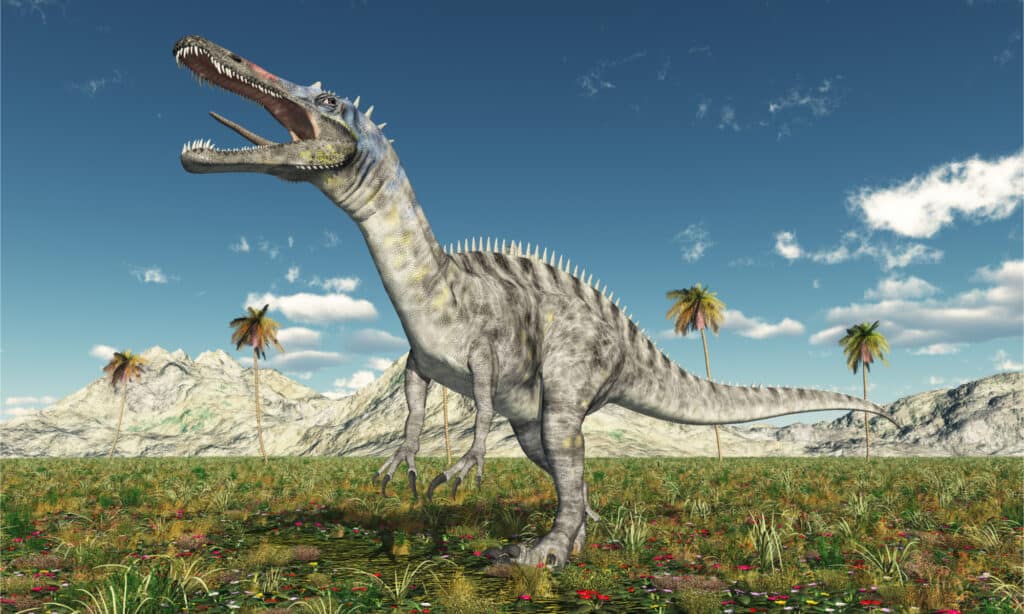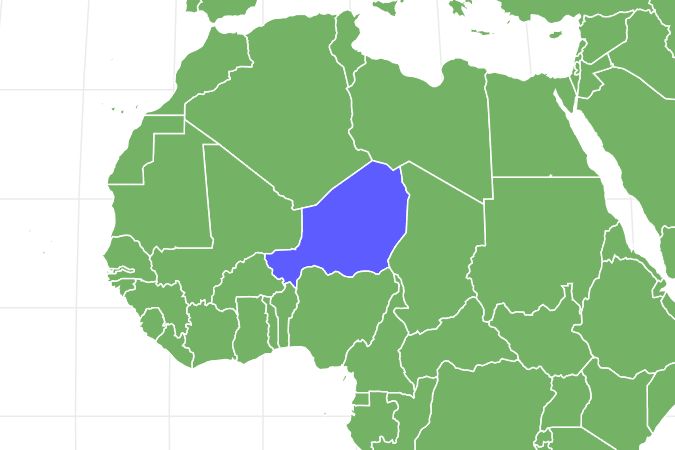Suchomimus
.jumbotron {
background-image: url(“https://a-z-animals.com/media/2022/06/Suchomimus-in-a-forest-400×300.jpg”);
}
}
@media only screen and (min-width: 641px) and (max-width: 920px) {
.jumbotron {
background-image: url(“https://a-z-animals.com/media/2022/06/Suchomimus-in-a-forest-470×370.jpg”);
}
}
@media only screen and (min-width: 921px) {
.jumbotron {
background-image: url(“https://a-z-animals.com/media/2022/06/Suchomimus-in-a-forest.jpg”);
}
}
Suchomimus
Suchomimus tenerensis
It walked on two legs and leaned forward
Suchomimus Scientific Classification
- Kingdom
- Animalia
- Phylum
- Chordata
- Family
- Spinosauridae
- Genus
- Suchomimus
- Scientific Name
- Suchomimus tenerensis
Read our Complete Guide to Classification of Animals.
Suchomimus Conservation Status
Suchomimus Facts
- Fun Fact
- It walked on two legs and leaned forward
- Biggest Threat
- Carnivorous dinosaurs
- Most Distinctive Feature
- A long snout similar to a modern crocodile…with 122 teeth!
- Distinctive Feature
- It’s tremendous size — up to 36 feet long!
- Diet
- Omnivore
- Favorite Food
- Fish — it was primarily, if not exclusively, pescatarian
- Special Features
- They may have had sail structures along their backs.
This post may contain affiliate links to our partners like Chewy, Amazon, and others. Purchasing through these helps us further the A-Z Animals mission to educate about the world’s species..

Spiders that fly! Fish that walk! And 1000+ more incredible animals. Discover them all for FREE
.photo-gallery {
–margin: 0px auto 0px;
–padding: 0px 0px 0px 0px;
}
.gallery-link {
background-image: url(“https://a-z-animals.com/media/2022/06/Suchomimus1-1024×614.jpg”);
background-repeat: no-repeat;
background-size: cover;
background-position: center;
height: 500px;
justify-content: center;
text-align: center;
align-items: center;
display: flex;
border: 2px solid #000;
}
.gallery-link img {
height: 50%;
}
@media only screen and (max-width: 768px) {
.gallery-link {
height: 300px !important;
}
}
View all of the Suchomimus images!
The dinosaur known as the “crocodile mimic” was incredibly fearsome.
This dinosaur could get up to 36 feet with a long snout similar to a modern crocodile. Fortunately for other dinosaurs, this dinosaur was a pescatarian and only ate fish. It lived during the Early Cretaceous in what is present-day Niger.
Suchomimus Species, Types, and Scientific Name
Suchomimus tenerensis is the only species within the Suchomimum genus. It is part of the Spinosauridae family, along with well-documented dinosaurs such as Spinosaurus and Baryonyx. Spinosaurids were theropod dinosaurs with hollow bones and three-toed limbs that mostly lived in the Cretaceous Period.
The Baryonyx is a genus of Spinosaurid that lived in Europe at the same time as the Suchomimus and shared many similarities with the Suchomimus. Some researchers believe that they were actually in the same genus and possibly even the same species of dinosaur. You may see them referred to synonymously, although the official classification still identifies them as two distinct species and genera.
Suchomimus belongs to the Theropoda clade, along with the other Spinosaurids. Other notable theropods include the Tyrannosaurus rex and the Velociraptor. The Suchomimus was part of the Chordata phylum and Animalia kingdom. See the full taxonomy below to find out how these classifications fit in with each other and the entire Animal kingdom.
Suchomimus
| Kingdom | Animalia |
| Phylum | Chordata |
| Family | Spinosauridae |
| Genus | Suchomimus |
| Species | Suchomimus tenerensis |
Description and Size
Suchomimus was around 31-36 feet long and weighed between 3 and 5 tons. It was one of the larger Spinosaurids, but still not as large as the Spinosaurus. It had a long tail, which helped it balance since it walked on two legs and leaned forward. Its neck was shorter and heavily muscled. It had two forearms that were much shorter and it may have been able to grasp smaller items, including other dinosaurs. Sharp claws on their front arms suggest that they used these
Its spine had some elongated neural spines that may have supported sail structures. These were most prominent along its back. They were not as large or developed as those of Spinosaurus, although they were larger than those found in the Baryonyx. Researchers theorize that the Suchomimus may have had smaller sails. Another possibility is that the discovered specimen was not fully grown and that these sails further developed until they reached adulthood.
One of the most notable features of the Suchomimus is its long, crocodilian snout. The snout was long and low, well below its eyes. They had 122 teeth. Although they were pointed, they weren’t sharp or serrated. This was one reason that scientists believed they probably had pescatarian diets.
Suchomimus had a hard secondary palate in its mouth. This would have helped them maintain control over wiggling fish in their mouths. Its snout was up to 4 feet long and accounted for a significant portion of its body.

Michael Rosskothen/Shutterstock.com
Diet – What Did Suchomimus Eat?
With their long snouts, Suchomimus probably ate mostly fish. Its features helped them catch fish. These included the claws on their forearms, perfect for clutching fish. Their hard secondary palate could keep wriggling fish inside their mouths as they ate. The Baryonyx, which is closely related, was known to eat fish. Paleontologists even found the remains of fish scales in their stomachs. Based on that evidence and the similar features, they think that Suchomimus had a similar diet.
Suchomimus’ light, hollow bones probably made it difficult for them to dive down into the water to hunt for food, however. It is more likely that they found fish in shallow waters.
Dinosaur teeth tell scientists a lot about what these animals ate. The discovery of a full jaw of teeth was crucial to determining the diet of the Suchomimus. Their teeth were pointed but not particularly sharp. They also lacked the serrated edges common in carnivorous dinosaurs.
Most researchers believe that Suchomimus did eat some meat, likely more scavenging than actively hunting. Their teeth were not sharp enough to deliver a killing blow to most dinosaurs of the time.
Habitat – When and Where It lived
Suchomimus lived in the Early Cretaceous, between 125 and 112 million years ago. It lived during the Aptian geological period into the Albian period. Researchers analyze the rock formations and sediment around Suchomimus fossils to determine exactly when they lived.
These dinosaurs lived in present-day Niger. A fossilized skeleton was discovered in the Elrhaz Formation. This rock formation dates back to the Early Cretaceous, around 112 million years ago. Based on analysis of the minerals found at the site, researchers believe that it was an inland freshwater environment during Suchomimus’ time. It probably had rivers and floodplains that provided food for Suchomimus. Other animals that flourished in that environment would have included fellow theropod Kryptops, herbivores in the Iguanidontia clade, and the ancient relatives of crocodiles, the Crocodylomorphs.
Threats and Predators
Carnivorous dinosaurs would have posed the biggest threat to the Suchomimus.
Their large claws probably helped Suchomimus fight off potential predators, but they were still vulnerable. They were large enough to be tough prey to take down but didn’t have the razor-sharp teeth that some other dinosaurs had.
Competition for resources was an ever-present threat for all dinosaurs, including Suchomimus. While they could probably eat both fish and meat, if there was a shift in available food, Suchomimus would have had trouble surviving. Their diets were more specialized than some other dinosaurs that lived longer or adapted.
Young Suchomimus
Suchomimus laid eggs to reproduce. Scientists do not know how many eggs a female Suchomimus laid at one time, but they know that the Suchomimus did lay eggs. Many dinosaurs were vulnerable to predators as eggs or as young, newly hatched dinosaurs.
Discoveries and Fossils – Where It Was Found
Suchomimus is a relatively new discovery, found and named in 1997 by paleontologist Paul Sereno. He initially found one of the powerful claws. As his team excavated the site, more remains of the fossilized skeleton were discovered.
The Suchomimus holotype, the specimen that was used to describe the species, contains ribs and vertebrae, a shoulder blade, most of the pelvis bone, and parts of the forelimbs and hindlimbs. It does not include a skull. To analyze the skull, researchers used another specimen that included the snout, one of the key features of a Suchomimus.
Extinction – When Did It Die Out?
Researchers do not know exactly when or why the Suchomimus went extinct. All of the known specimens are from the Early Cretaceous, around 125 to 112 million years ago. They had a specialized fish diet, similar to the Spinosaurus. Scientists theorize that this diet and the scarcity of food contributed to their struggle to survive. Because they did not adapt to changing food sources, they eventually went extinct.
Similar Animals to the Suchomimus
Other Spinosaurids were closely related to the Suchomimus and shared many similar features.
- Spinosaurus: These dinosaurs were much larger than Suchomimus and had a much larger sail. They lived primarily in water during the Late Cretaceous.
- Baryonyx: This smaller dinosaur shares so many similarities to Suchomimus that some scientists believe that it is actually a juvenile specimen of the same species. They also lived during the Early Cretaceous.
View all 186 animals that start with S
Suchomimus FAQs (Frequently Asked Questions)
When did Suchomimus live?
Suchomimus lived during the Early Cretaceous Period. Fossils discovered date to between 125 and 112 million years ago.
How big was Suchomimus?
Suchomimus was around 31-36 feet long and weighed between 3 and 5 tons. Some researchers believe that the smaller Baryonyx was actually a juvenile specimen of the Suchomimus.
Sources
- Prehistoric Wildlife, Available here: http://www.prehistoric-wildlife.com/species/s/suchomimus.html
- Natural History Museum, London, Available here: https://www.nhm.ac.uk/discover/dino-directory/suchomimus.html
- Suchomimus Fact Sheet, Available here: https://www.enchantedlearning.com/subjects/dinosaurs/facts/Suchomimus/
















